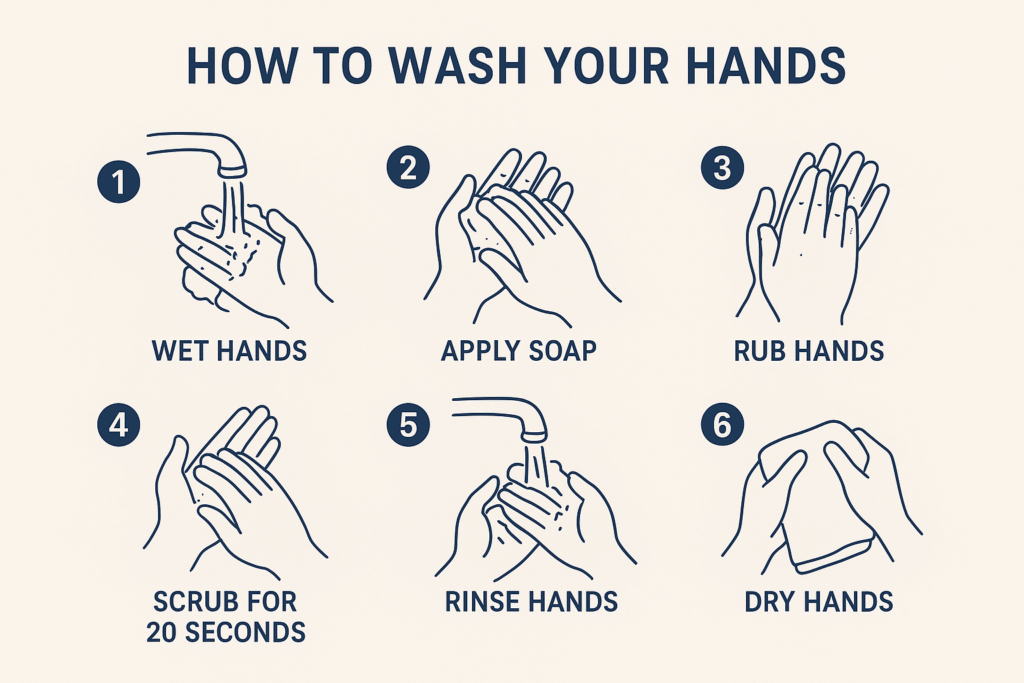To ensure patients’ safety, comfort, and overall well-being, it is essential to prioritize hygiene and infection control when providing care at home, in a hospital, or in a caregiving facility. If hygiene is not maintained correctly, infections may hinder recovery or even pose a life-threatening threat. Some 3.85 billion people around the world rely on health care facilities that lack basic hygiene services needed to prevent and control the spread of disease, increasing the risk of infection, according to a report from UNICEF and the World Health Organization. Considering this alarming report, caregivers must learn basic care skills and implement hygiene practices and infection control measures consistently.
Infection Control and Hygiene: Why They Matter
We all carry microorganisms on our skin, in our mouths, and throughout our bodies. Human health depends on microorganisms. In some cases, these organisms can cause infections, especially when the immune system is not as strong as it should be. Patients recovering from illness, surgery, or chronic conditions are at greater risk of infection. Therefore, caregivers must maintain strict hygiene standards to prevent the spread of germs.
Hygiene Principles to Control Infections (Basic Care Skills)
1. Hand Hygiene – The First Line of Defense
Infections can be prevented easily and effectively by keeping your hands clean.
Wash Your Hands:
- After and before touching the patient
- Before preparing or serving food
- After using the bathroom
- If you have handled waste, dressings, or dirty laundry
How to Wash Your Hands Properly:
- Wet your hands with clean running water.
- Lather up for at least 20 seconds with soap.
- All parts of the hands should be cleaned: between the fingers, under the nails, and at the wrists.
- After rinsing, dry with a clean towel or allow to air dry.

If water isn’t available, use alcohol-based hand sanitizer (at least 60% alcohol).
2. Personal Hygiene for Caregivers and Patients
- Clean clothing: Make sure you change into clean clothes daily, especially after taking care of yourself.
- Oral hygiene: Assist patients in brushing their teeth or cleaning their dentures twice daily to prevent mouth infections.
- Regular baths or bed baths: Providing patients with regular baths or bed baths can keep their skin clean and reduce bacteria buildup.
- Hair and nails: Keep your nails short and clean, and avoid wearing jewelry while caring for them.
3. Environmental Hygiene
Infection risks are significantly reduced in a clean environment.
- Disinfect frequently touched surfaces such as bed rails, doorknobs, and tables.
- Bedding should be changed regularly, and if it is soiled, it should be changed as soon as possible.
- Maintain proper ventilation by allowing fresh air and sunlight into the room whenever possible.
The Basics of Infection Control
1. Wearing Personal Protective Equipment (PPE)
Wear gloves, masks, or gowns whenever necessary to protect yourself against infections, blood, and body fluids. After use, all PPE should be disposed of safely.
2. Handling of Contaminated and Waste Materials
- Medicinal waste, such as used gloves or dressings, should be disposed of in designated containers.
- Never reuse disposable items.
- Wash towels and patient clothes in hot water with detergent.
3. Preventing Cross-Contamination
- Personal items like towels, razors, and combs should never be shared.
- Different cleaning cloths should be used for different areas (bathroom, bedroom, etc.).
The Right Time to Seek Medical Attention
Consult with a healthcare professional immediately In case of fever, redness, or other symptoms of infection around the wound, unusual discharge, or persistent coughing. Early intervention can save lives.
Creating a Hygiene Culture in Caregiving: Tips and Resources
Encouraging a culture of hygiene and infection control within caregiving environments is critical for safeguarding the health of both caregivers and patients. This culture begins with education and training, ensuring that all caregivers understand the importance of hygiene practices. Regular workshops and training sessions can be effective in infection prevention, proper hand hygiene techniques, and the use of personal protective equipment (PPE).
In addition to training, creating an environment that prioritizes cleanliness and safety is equally important. Caregiving facilities (professional and family) should maintain high standards of cleanliness by ensuring that common areas, patient rooms, and medical equipment are routinely cleaned and disinfected.
There are numerous resources available for caregivers aiming to foster a culture of hygiene. Training programs offered by health organizations, hygiene checklists for daily practices, and guidelines from authorities such as the Centers for Disease Control and Prevention (CDC) can be invaluable in promoting effective hygiene measures. Utilizing these resources can significantly enhance hygiene practices within caregiving settings, ultimately leading to improved health outcomes for patients.
Remember:
Infection control and proper hygiene protect both the patient and the caregiver. When you make these practices a habit, you create a healthier, safer environment that promotes healing and reduces health risks. The key to saving lives is clean hands and clean habits.





